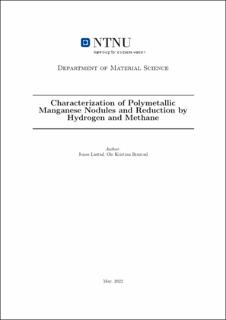| dc.contributor.advisor | Safarian, Jafar | |
| dc.contributor.advisor | Hoseinpur-Kermani, Arman | |
| dc.contributor.author | Brustad, Ole Kristian | |
| dc.contributor.author | Låstad, Jonas | |
| dc.date.accessioned | 2022-07-09T17:20:24Z | |
| dc.date.available | 2022-07-09T17:20:24Z | |
| dc.date.issued | 2022 | |
| dc.identifier | no.ntnu:inspera:113533417:113534368 | |
| dc.identifier.uri | https://hdl.handle.net/11250/3004353 | |
| dc.description.abstract | Feltet havbunns gruvedrift har blitt utforsket siden 1800-tallet, med stor utvikling rundt 1970-
tallet. P˚a grunn av en økning i etterspørselen etter verdifulle metaller slik som kobber, kobolt
og nikkel har dette feltet f˚att gjenvunnet interesse. Clarion Clipperton sonen inneholder enorme
reserver av polymetalliske noduler rike p˚a mineraler av mangan, jern, kobber, nikkel og kobolt s˚a
vel som mineraler av sjeldne jordarter.
En annen utvikling har vært behovet for ˚a redusere karbonavtrykket til metallproduksjonen.
Dermed utforskningen av gassbaserte reduksjonsprosesser, ved bruk av hydrogen og/eller metan
som reaksjonsmiddler mer og mer relevante.
Denne rapporten utforsker en overg˚aende prosess med kalsinering og reduksjon ved bruk av ulike
av konsentrasjoner av metan og hydrogen som reduksjonsmidler. Malmen brukt i denne oppgaven
kommer opprinnelig fra Clarion Cliperton sonen i Stillehavet.
Resultatene gitt i denne rapporten ble funnet ved:
• Kjemisk analyse av r˚a og kalsinert malm ved XRF.
• Spesifikt overflateareal av kalsinert malm funnet via BET metode.
• Thermogravimetrisk analyse av kalsinasjon og reduksjonsprosessene.
• Elektronmikroskopi av den r˚a, kalsinerte og reduserte malmen.
• Grunnstoff fordelingen i den r˚a, kalsinerte og reduserte malmen, funnet via SEM-EDX.
• Røntgendiffraksjonsmønstre av den r˚a, kalsinerte og reduserte malmen.
Hovedfunnene i denne rapporten kan oppsummeres som:
• Polymetalliske noduler vil danne metallisk jern, nikkel og kobber n˚ar det blir redusert ved
900◦C i et miljø med god tilgang p˚a reduksjonsmidel av metan eller hydrogen. Faser av
kobolt ble ikke identifisert, men vil teoretiskt sett ogs˚a reduseres til en metallisk fase, og kan
ha legert seg med et annet metall.
• Det ble ikke oppdaget karbider i noen av de reduserte prøvene.
• Manganoksid ble redusert til stadiet MnO.
• Silisium innholdet i de polymetalliske nodulene p˚avirker fasesammensettingen til de reduserte
prøvene. Silisium g˚ar i fase med elementer av mangan og jern og danner faser av fayalitt og
tefroitt.
• Aluminium i den reduserte prøven g˚ar i fase med silisium, natrium og kalium i nefelin.
• En økning i porositeten av polymetalliske mangannoduler under kalsinering tillater for enkel
massetransport av reagenser og avgasser, noe som mulig kan tillate for prossessering uten et
pelletiseringsstadie.
• Reaksjonshastigheten til reduksjone er høy og virker eksotermisk. | |
| dc.description.abstract | The field of subsea mining has been investigated since the 19th century with a heightened interest
arising in the 1970’s. Due to an increase in demand of valuable metals such as copper, cobalt, and
nickel this field is once again experiencing heightened interest. The Clarion Clipperton Fracture
Zone contains vast reserves of polymetallic manganese nodules which contains considerable amounts
of minerals of manganese, iron, copper, nickel, and cobalt as well as other minerals such as rare
earths.
Another development is the need to reduce the carbon footprint of metal production. As such
the exploration of gaseous reduction processes, utilizing hydrogen and/or methane as reactants, is
becoming more and more relevant. This bachelor thesis investigates an overall process of calcination
and reduction utilizing various mixtures of methane and hydrogen as reduction agents. The ore
used in this study originated from the Clarion Clipperton Fractured Zone.
The results given in this paper was found by:
• Chemical analysis of the raw and calcined ore by XRF.
• Specific surface area of the calcined ore found by BET.
• Thermogravimetric analysis of the calcination and reduction process.
• Electron microscope images of the raw, calcined and reduced ore.
• Element distribution in sample by SEM-EDX.
• X-ray diffraction patterns of the raw, calcined and reduced ore.
The main findings of this paper is that:
• Polymetallic manganese nodules will produce metallic iron, nickel, and copper when reduced
at 900◦C in an environment with readily available reactants of either methane or hydrogen
gas. Phases of cobalt was not identified, but is theoretically reduced to a metallic state, and
may have alloyed with another metal.
• No carbide was found in the samples reduced by methane-containing gases
• Manganese oxides were reduced to a phase of manganosite (MnO).
• Silicon content of the ore greatly affected the reduced samples, binding elements of manganese
and iron into phases of fayalite and tephorite.
• Aluminium in the reduced sample entered phases with silicon, sodium and potassium in
phases of nepheline.
• The increase in porosity of the manganese nodules during calcination allows for easy mass
transport of reactants and gaseous reduction products, possibly allowing for processing
without a pelletization stage.
• The reaction speed of the reduction is significant and appear exothermic in nature. | |
| dc.language | eng | |
| dc.publisher | NTNU | |
| dc.title | Characterization of Polymetallic Manganese Nodules and Reduction by Hydrogen and Methane | |
| dc.type | Bachelor thesis | |
